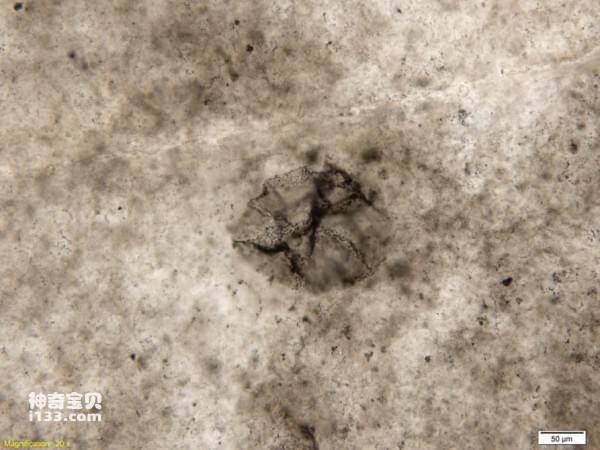The single Aeolian fossil found in southern Africa is the oldest bacterial fossil discovered by scientists so far, and is also the oldest representative of all paleontological fossils. Eosobacterium is a prokaryotic organism, and dating indicates that it lived 3.2 billion years ago. Since the earliest biological types on earth, such as Eobacteria alone, are single-celled organisms with very primitive structures, even if they form fossils, they are very light, fragile, and fragile. Therefore, scientists have not discovered the origin of these primitive life forms for a long time. Other reliable fossils.

Later, when some scientists analyzed the origin of the weathered strip-like iron-rich ore in sedimentary rocks, they discovered that this iron-rich ore was formed by an ancient microorganism - iron bacteria; moreover, the formation of these iron-rich ores The existence of iron bacteria in rich iron deposits can be traced back to 3.2 billion years ago.
Iron bacteria have the common characteristics of general bacteria. They are single-celled organisms with a diameter of only a few microns to tens of microns. They are prokaryotes without a nucleus in their cells. They can only be discovered under a microscope that is magnified thousands of times. Some iron bacteria cells are oval or rod-shaped, and are connected to each other to form a rather long thread. Some individual iron bacteria are just a thin and long thread; some iron bacteria are spherical, arc-shaped or rod-shaped with handles or Branched morphology; some iron bacteria form nodules, ribbons or spirals. These iron bacteria are wrapped in a thin layer of "iron armor" - a sheath.
Iron bacteria ingest inorganic substances such as iron and silicic acid during their life. In swamps and lakes, iron usually exists in the form of soluble ferrous hydroxide. After being absorbed by iron bacteria, it is oxidized into insoluble ferric oxide through the catalysis of enzymes in the bacteria.
These insoluble iron compounds, silicides and other inorganic substances are secreted out of the body by iron bacteria, forming a sheath with iron as the main component. Interestingly enough, the skin sheaths of iron bacteria are often several or dozens of times larger than their bodies. Iron bacteria can move back and forth in the sheath, and sometimes can extend out of the sheath to rebuild a new sheath, and the fallen sheaths settle in the water and accumulate into iron ore. You may not imagine that this kind of iron bacteria that lived hundreds of millions of years ago actually became a "skilled craftsman" in making iron through such a lifestyle, providing today's mankind with extremely rich iron ore resources.
In the Precambrian sedimentary rocks of the United States, Canada, the Soviet Union, Australia, India and southern Africa from 1.8 billion to 3.2 billion years ago, scientists have discovered striped iron ore layers, which generally contain iron bacteria fossils. If you grind rocks or ores into thin slices and observe them under a high-magnification biological microscope or electron microscope, you can see the fossilized iron bacteria.
Due to insufficient research on iron bacteria fossils from ancient times, only more than a dozen species have been discovered. They are somewhat similar to modern iron bacteria, but different. Some of these species have become extinct. Of course, the species at that time are by no means equal to modern species. For example, linear archaeal iron bacteria are very similar to modern linear iron bacteria. They both have skin sheaths, but the ancient ones are much larger than the modern ones.
Iron bacteria are mostly aerobic microorganisms, but they do not require much oxygen. Scientists speculate that the earth's atmosphere 3.2-3.4 billion years ago was highly reducing. At that time, there was almost no oxygen in the atmosphere, only carbon dioxide, methane and hydrogen. By 3.2-3.1 billion years ago, cyanobacteria appeared. In the years that followed until 2.7 billion years ago, these cyanobacteria ingested the original reducing atmospheric carbon dioxide, carried out photosynthesis through chlorophyll, produced free oxygen and released it into the atmosphere, gradually increasing the oxygen content in the atmosphere. , which provides good living conditions for aerobic iron bacteria, thus ensuring that they can continuously absorb ferrous hydroxide in the water and oxidize it into water-insoluble ferric oxide and deposit it to the bottom of the water.
It can be seen that the distant ancestors of bacteria that often cause panic and misunderstanding among people today not only laid the biological foundation for the evolution and development of the entire biological world in the years to come, but some of their molecules also provided the basis for the development of today's intelligent creatures-human beings. Progress has accumulated indispensable mineral resources.
animal tags:
We created this article in conjunction with AI technology, then made sure it was fact-checked and edited by a Animals Top editor.